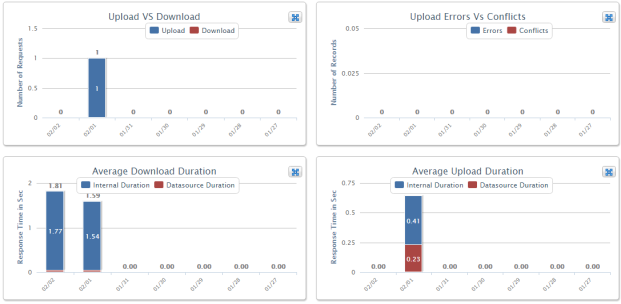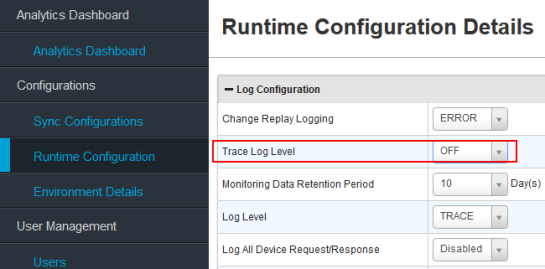Monitor and Tune Kony Fabric Sync Server Performance
Kony Fabric Sync Server deployment environment changes over time. User populations grow, processing requests tend to increase in number and complexity, and network capacity and other aspects of infrastructure may be modified.
These changes can affect Kony Fabric Sync Server performance. As a result, it is important to monitor and tune performance regularly.
Monitoring performance means checking status of your Kony Fabric Sync Server and its resources regularly. Kony Fabric Sync Server provides metrics for checking the performance of the system and services.
Kony Fabric Sync Console provides a view of the requests that the server received and time it took to execute those requests. These requests are either for downloading the delta dataset or for uploading changes from device to the enterprise datasource.


Tuning can involve adjustments in the following areas:
- Kony Fabric Sync Server: Adjust your application server memory and connection settings as required for better performance.
- Databases: Keep your databases optimized for querying and reporting.
Tune Kony Fabric Sync Server Installation
- Enable GZIP Compression
Compression is a simple, effective way to save bandwidth and speed up the bulk download response times. Simply put gzip compression works by finding similar strings within a text file, and replacing those strings temporarily to make the overall file size smaller. This form of compression is particularly well-suited for the Kony Fabric Sync responses.
For more information on minimum size of compression, refer to compressionMinSize in the following URL: https://tomcat.apache.org/tomcat-7.0-doc/config/http.html.
To ensure that GZIP compression is turned for Tomcat make sure you see similar tag in
<TOMCAT_INSTALL_DIR>\conf\server.xml.<Connector port="8080" protocol="HTTP/1.1" connectionTimeout="20000" redirectPort="8443" compression="on" compressionMinSize="512" noCompressionUserAgents="gozilla, traviata compressableMimeType="text/html,text/xml,text/css,text/plain,text/javascript,application/x-javascript,application/javascript,application/json,application/xml"/>
For other application servers please refer to the Server Configuration/Administration Guide for enabling GZIP compression.
- Disable DEBUG logging in Production Environments
A debug log records database operations, system processes and errors that occur when executing a transaction during development lifecycle. The system generates a debug log for a user every time that user executes requests for an upload or download operation (or even device registration).
Debug logs slow down the application performance as the server spends a lot of time performing the input and output (I/O) operations to capture the LOG statements. In a production environment, the user is typically interested to know only runtime errors and do not need a complete log trace for every user.
Ensure that below logger is set to ERROR in
log4j.propertiesfile.For Kony Sync 5.0.X, the
log4j.propertiesfile is located at:<sync.home>/apache-tomcat-7.0.26/webapps/syncconsole/WEB-INF/classes/log4j.properties<sync.home>/ apache-tomcat-7.0.26/webapps/syncservice/WEB-INF/classes/log4j.propertiesFor Kony Sync 5.5.X, the
log4j.propertiesfile is located at:<sync.home>/conf/console-log4j.properties<sync.home>/conf/services-log4j.propertiesNote: Once you modify the
log4j propertiesfile, you need to removesyncconsole.warandsyncservice.warfromwebappsfolder, otherwise it gets overridden again on tomcat start. - Disable Trace Logs in Production Environments
Tracelogs enable the administrator to view incoming HTTP requests and responses. This is very useful to debug issues during development. It impacts the application server performance. So unless you debug an issue, you should turn off the Tracelogs.
To turn off the trace logs follow these steps:
- Log on to Kony Fabric Sync Management Console.
- Click Configurations > Runtime Configuration.
- In Log Configuration, select OFF from the Trace Log Level checkbox as follows:

Tune Database
Kony Fabric Sync implementation uses a relation database (Microsoft SQL Server or Oracle) to store user information and log performance metrics. To ensure that Kony Fabric Sync implementation continues to perform well, it is important to maintain the performance of your database.
This means optimizing it for querying, reporting, and analyzing. If Kony Fabric Sync and other applications demand more of a database than it can provide, or if queries are too large for a database to handle efficiently, you may experience increased response times and degradation in Kony Fabric Sync performance and scalability.
For information about tuning your database, see its documentation.
| Copyright © 2013 Kony, Inc. All rights reserved. |
